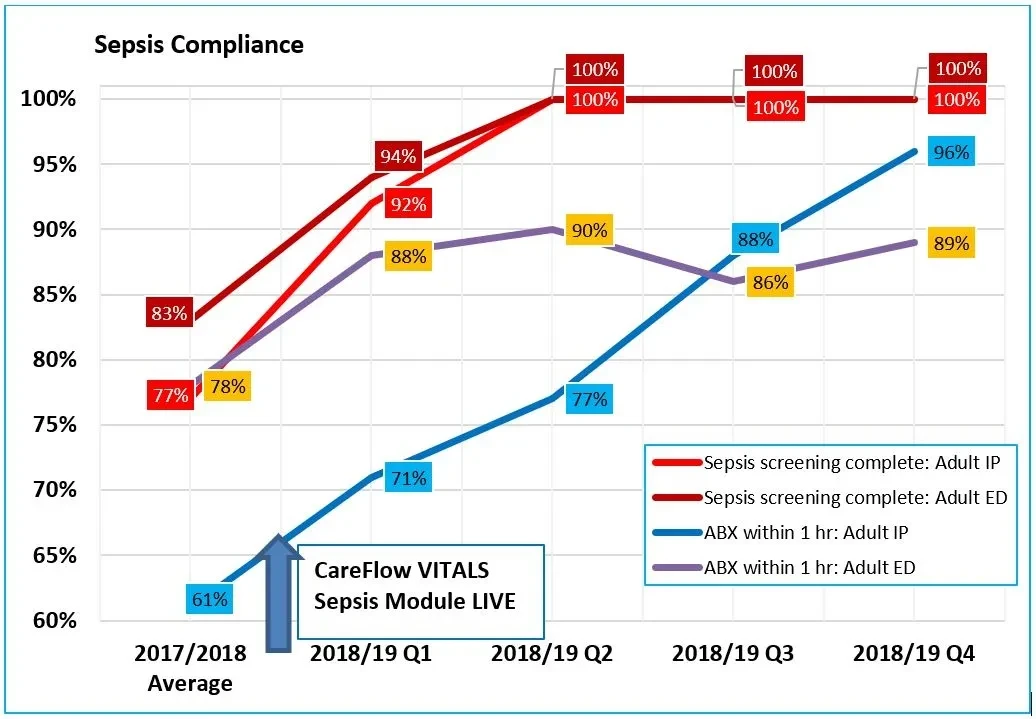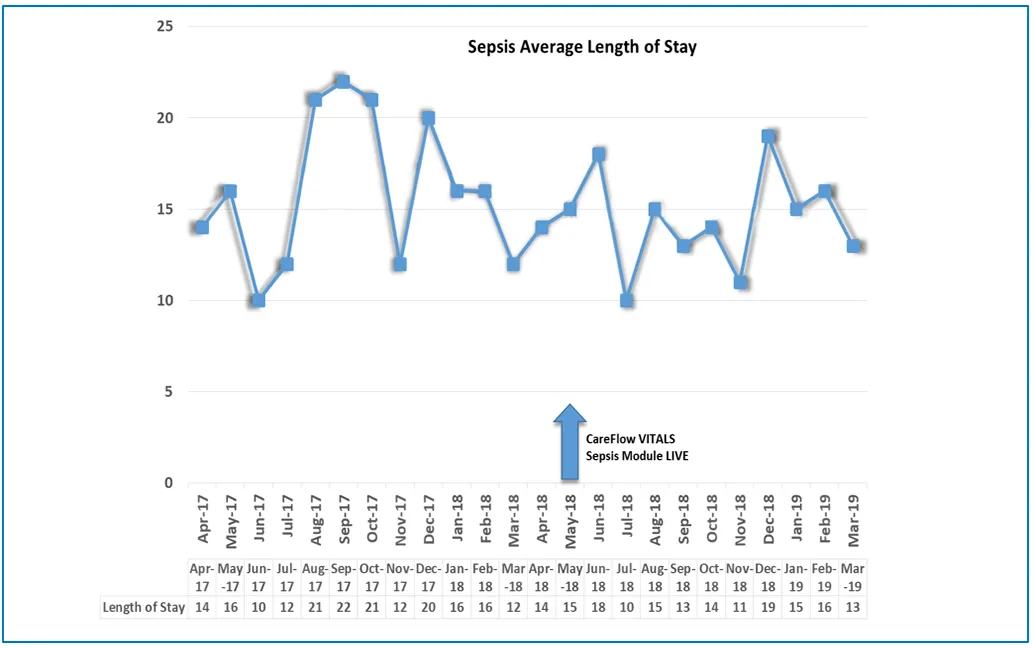You are here:
- Home
- >
- Resources
- >
- Case studies
- >
- CareFlow Vitals Delivers Marked Sepsis Improvement at Barnsley.
Since introducing e-observations software, Barnsley Hospital NHS Foundation Trust has seen immediate and marked improvements in recognising and treating sepsis, and ultimately in improving patient safety outcomes.
The Trust is now among the best performing trusts in the country in its identification and treatment of patients with sepsis.

When patients do contract sepsis, Vitals has enabled earlier identification and treatment, which has in turn meant that patients stay on average 1.5 days less in intensive care.

Barnsley Hospital NHS Foundation Trust is a 350+ bedded district general hospital in South Yorkshire, covering a population of over a quarter of a million. Last financial year, it cared for more than 67,000 patients in the hospital and currently treats 100,000 in the emergency department.
Sepsis is a life-threatening condition which occurs when the body responds poorly to a bacterial infection and attacks its own tissue and organs. It is notoriously hard to spot and if not treated immediately, can result in organ failure and death. However, with early diagnosis it can be treated effectively with antibiotics (The Sepsis Trust 2019). NHS England attributes around 32,000 deaths in England to sepsis annually. Of these it is estimated that 11,000 could have been prevented (NHS England 2016).
The sepsis CQUIN was introduced in 2015-16 and extended in 2016-17. It incentivises the screening, identification and treatment of sepsis in emergency department and acute inpatient settings.
CareFlow Vitals is our market leading electronic observation and decision support system designed to improve patient safety and outcomes. It monitors and analyses patient vital signs to identify deteriorating conditions and provide risk scores to trigger escalation pathways. Within the core Vitals module there is the ability for hospitals to switch on the sepsis module. This module delivers comprehensive functionality to identify, risk-stratify and audit the delivery of appropriate care for patients with potential sepsis, in accordance with published guidance.
Users enter the patient’s vital signs observation data into an iPod at the bedside. If there are any signs of sepsis within those observations, a sepsis alert is generated. Using iconography, this alert is immediately visible to clinical staff on all Vitals platforms. The person entering the data is given guidance on what to do next, including doing a full sepsis assessment to confirm the deteriorating vital signs is reflective of a sepsis risk, and completion of the Sepsis 6 checklist.
Following the successful roll out of CareFlow Vitals to all inpatient areas and the Emergency Department, Barnsley Hospital successfully added the sepsis functionality to the system in May 2018. Using the data entered for its CQUIN reporting, the Trust was able to clearly identify an improvement in the assessment of and early treatment of sepsis.
The data collected for the CQUIN demonstrates the following improvements:
|
Number of cases reviewed for patients, who developed a need for sepsis screening during an in-patient stay. |
17/18
Average |
18/19
Q1 |
Q2 |
Q3 |
Q4 |
Average |
Improvement |
|
Percentage of patients reviewed where sepsis screening was completed. Adult In-patient |
77% |
92% |
100% |
100% |
100%
|
99% |
22% |
|
Adult Emergency Department |
83% |
94% |
100% |
100% |
100%
|
99% |
17% |
|
Timely treatment for sepsis in emergency departments and acute inpatient settings. |
17/18
Average |
18/19
Q1 |
Q2 |
Q3 |
Q4 |
Average |
Improvement |
|
The percentage of patients who were found to have sepsis and received antibiotics within 1 hour. Adult In-patient |
61% |
71% |
77% |
88% |
96% |
87% |
26% |
|
Adult Emergency Department |
78% |
88% |
90% |
86% |
89%
|
88% |
10% |
The table above demonstrates that from the introduction of sepsis functionality on CareFlow Vitals in May 2018 (Q1) there is an almost immediate improvement in screening to 100% in both inpatients and ED.
There is also a significant and incremental improvement over the year in the percentage of patients receiving antibiotics within 1 hour (Q4 figures: 96% of in-patients and 89% in ED). In addition, the lack of variation in the data demonstrates a sustained improvement in clinical practice.
The next step is to identify the impact of these improvements on patient outcomes. The Trust has already recorded a 1.5-day reduction in the average length of stay for sepsis patients, identified through ICU admissions. This dropped from an average 16 days per patient in 2017/18 to 14.5 days in 2018/19 following the introduction of Vitals.
Dr Dominic Bullas, Chief Clinical Information Officer at the Trust, explains:
The implementation of sepsis screening in Careflow Vitals has been a tremendous development for the Trust. We now have the technology to identify critically unwell or deteriorating patients, rapidly administer antibiotics, and establish plans for clinical escalation. This is a huge step forward with respect to patient safety and clinical outcomes.
Tracey Radnall, Head of Patient Safety and Quality Improvement at the Trust describes how:
The visibility of the risk of sepsis through the icon across all of the CareFlow Vitals platforms and the subsequent transparent user accountability regarding the completion of the sepsis 6 has been the primary contributor to the improvement.
The Patient Safety Team add that:
Having accessible audit data available from CFV enabled us to feedback and improve quality in a more timely manner.
Dr James Griffiths, Consultant in Emergency Medicine and Clinical Lead for VTE & Sepsis, further explains:
Utilising CareFlow Vitals has enabled us to screen 100% of patients with suspected sepsis. This gives us a much better chance of instigating the treatment many of these patients need in a timely fashion.
References
NHS England (2016) Commissioning for Quality and Innovation (CQUIN). Guidance 2016/17; URL available at: https://www.england.nhs.uk/wp-content/uploads/2016/03/cquin-guidance-16-17-v3.pdf [downloaded 09/08/2019]
Sepsis Trust (2019) New guidelines for hospitals in England to cut sepsis deaths: URL available at: https://sepsistrust.org/new-guidelines-for-hospitals-in-england-to-cut-sepsis-deaths/ [downloaded 08/08/2019]
